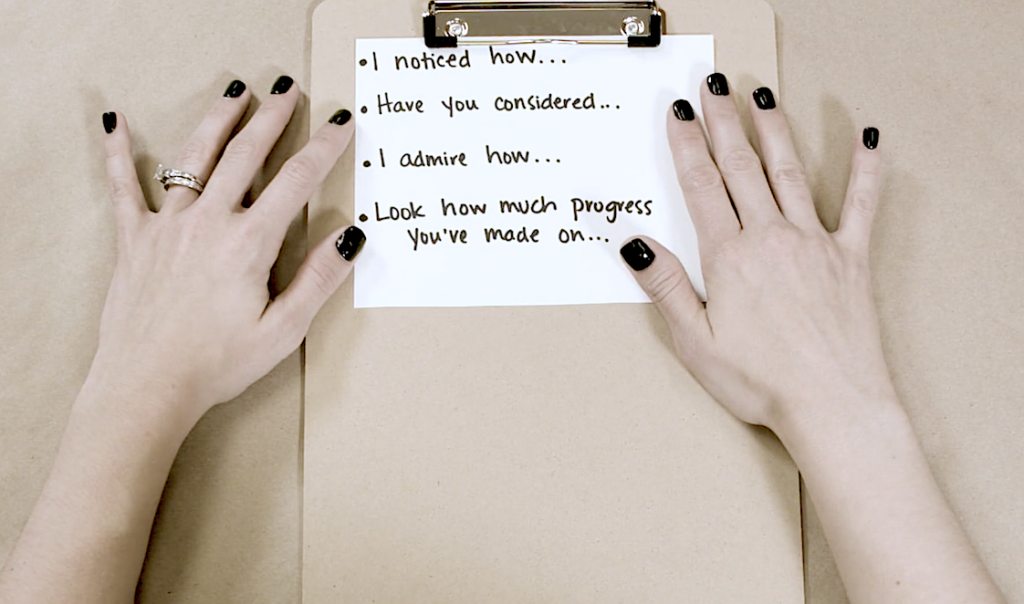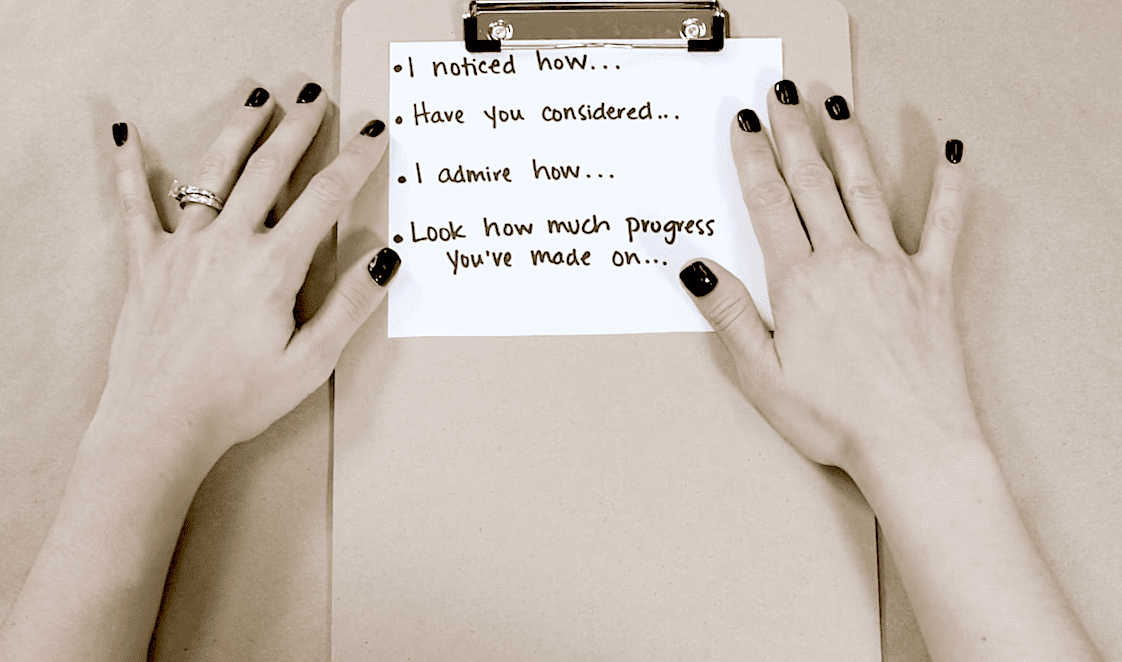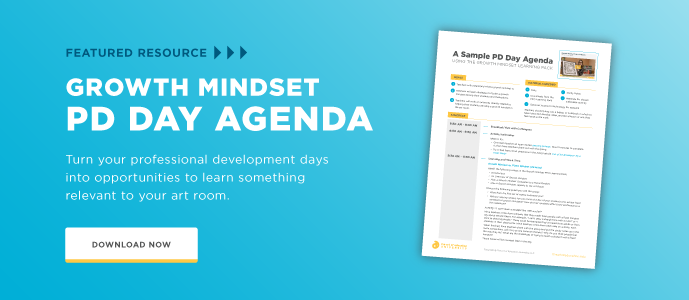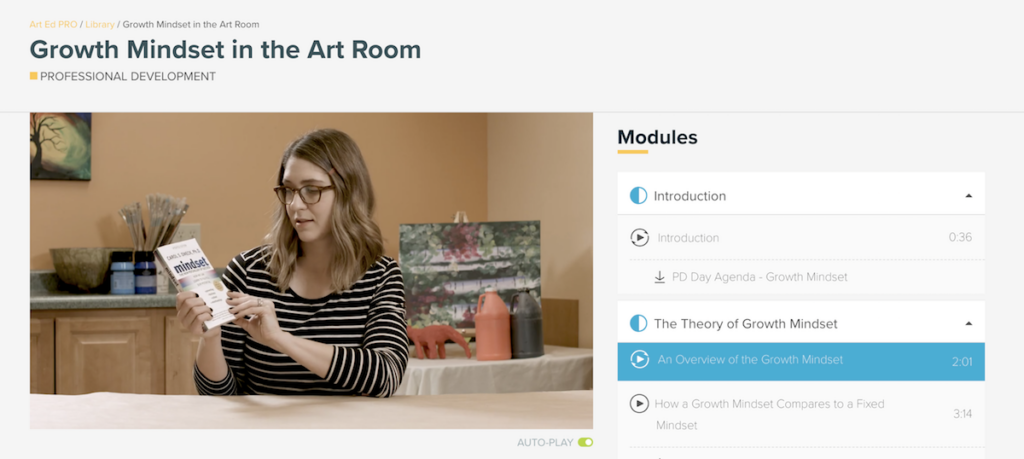Growth mindset is a hot topic in education right now, and for good reason. According to MindsetWorks, “7th graders who were taught that intelligence is malleable and shown how the brain grows with effort, showed a clear increase in math grades.”
In other words, if a student believes they can improve, they will.
Clearly, the effects of developing a growth mindset can be staggering.
Download our free Growth Mindset Agenda here to help you organize PD relevant to your art room.
But how, exactly, do you foster a growth mindset for your students?

Growth Mindset vs. Fixed Mindset
Before we dive in, let’s revisit exactly what a growth mindset is. The term, growth mindset, was coined by Carol Dweck Ph.D., a Professor of Psychology at Stanford. In her book, Mindset: The New Psychology of Success, Dweck summarizes her research on motivation.
Dweck found that people generally fall into one of two camps. In one group are people who believe talent is innate, and effort has no effect on the outcome. Dweck identified these individuals as having a fixed mindset. You might hear a person with a fixed mindset say something like, “Oh, I can’t even draw a stick figure!”
In the other group were people Dweck identified as having a growth mindset. People in this group believe with enough work and effort; they can improve their abilities. One phrase you might hear from a person with a growth mindset is, “I’m not able to do that yet, but I’m working on it!”
The Power of Language in Developing Growth Mindset
There are many things you can do to foster a growth mindset in your students. One of the most powerful is to shift your language.
Language permeates everything we do in the classroom from giving directions to demonstrating techniques to critiquing student work. Learning how to change your language to help students develop a growth mindset can be a game changer.
Here are 5 Ideas to Try

1. Use the power of “yet.”
One simple switch to make is to add the word “yet” to the end of a phrase. So, when a student says, “I can’t draw a person!” you can gently coach them to say, “I can’t draw a person, yet,” instead.
The addition of “yet” is powerful for students because it implies that they are not finished learning and eventually will reach their goal.
2. Switch to process praise instead of product praise.
You may think praising students is an effective form of feedback, but if you truly want to foster a growth mindset in your students, you have to be careful. Praising a student’s intelligence or talent can backfire.
Instead of saying, “Wow. Your colored pencil skills are incredible,” consider saying, “Wow. You have been working so diligently on your colored pencil skills.” This subtle shift helps the student see that their colored pencil skills are incredible because they have been working so hard. This helps students see that being good at art is not an innate talent, but something that is developed through hard work and dedicated practice.
If you’re interested in bringing this kind of language into your classroom, you can find a list of 20 examples of process praise in the Growth Mindset PRO Learning Pack. In addition, there’s an entire section related specifically to giving students effective feedback!

3. Create sentence stems.
Although these language shifts are subtle, it can take a while to break old habits. One tip is to create some sentence stems for yourself to use when talking with students. Write down phrases like the ones below and clip them to your seating charts, grade book, or anything else you routinely have out in your classroom as students are working.
- I noticed how…
- Have you considered…
- I admire how…
- Look how much progress you’ve made…
When you feel the urge to say, “That looks beautiful!” reach for your sentence stems instead.
4. Make growth mindset signage for your classroom.
In the same way you might use sentence stems, consider making signage for your classroom that reminds students to use growth mindset-centered language. You might create a poster that says “Remember the Power of YET,” or create an anchor chart with sentence stems for students to use. If you’re a PRO member, you can find ideas for what those might look like for students on the 17 Fundamental Phrases to Inspire a Growth Mindset download in the Growth Mindset Learning Pack.
5. Don’t forget about your own growth mindset.
As important as it is for you to use growth mindset language with students, it’s also important for you to use it with yourself! The next time you start thinking, “This student will never listen!” you might change that to, “Hm. I wonder what I can try with this student tomorrow.” Developing a growth mindset can empower you to be the best teacher you can be.
To Learn More
While incredibly important, changing your language only scratches the surface of what you can do in the classroom to help your students develop a growth mindset. If you’re interested in learning more, there are many great resources out there.
Here are three resources we recommend.
Growth Mindset PRO Learning Pack
If you’re looking for information about growth mindset directly related to your work in the art room, this is the place to start. This pack takes Dweck’s findings and breaks them down for K-12 art teachers. You’ll learn how to shift your teaching practice and art room setting to help your students develop a growth mindset. Topics include how to set up your classroom space to develop a growth mindset, the importance of giving students appropriately challenging work, and more.
Mindset: The New Psychology of Success
In this book, Carol Dweck summarizes her work. The book is far from dry and includes lots of anecdotes to help the reader understand the material. It’s a classic for a reason!
The Growth Mindset Playbook: A Teacher’s Guide to Promoting Student Success
This book, by Annie Brock and Heather Hundley, takes Dweck’s work and puts it in context in a general ed setting. Although this is not written specifically for art teachers, it does have great information that art teachers can apply.
Providing your students the opportunity to develop a growth mindset in your classroom is one of the greatest gifts you can give them. And what better place to do it than the art room? Remember to start slow and be gentle with yourself as you shift your language. Small tweaks can make a huge impact!
How do you foster a growth mindset among your students?
What are some examples of process praise you use with your students?
Magazine articles and podcasts are opinions of professional education contributors and do not necessarily represent the position of the Art of Education University (AOEU) or its academic offerings. Contributors use terms in the way they are most often talked about in the scope of their educational experiences.







